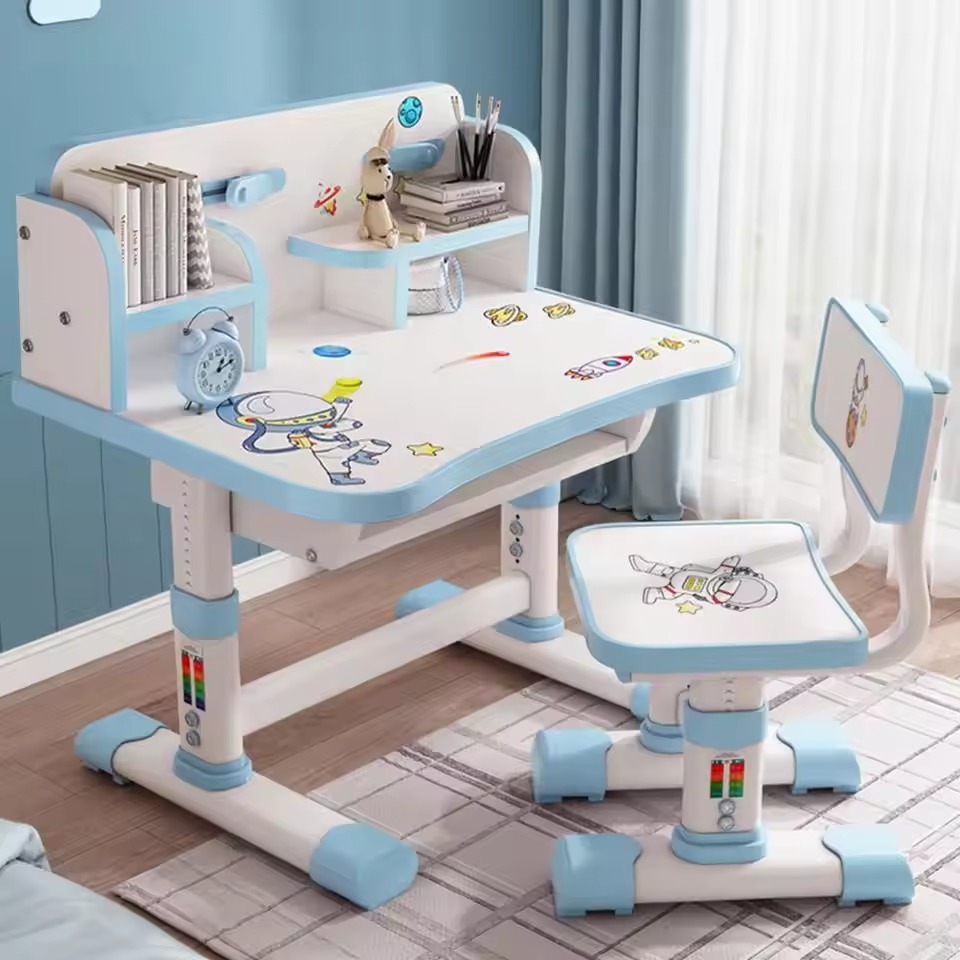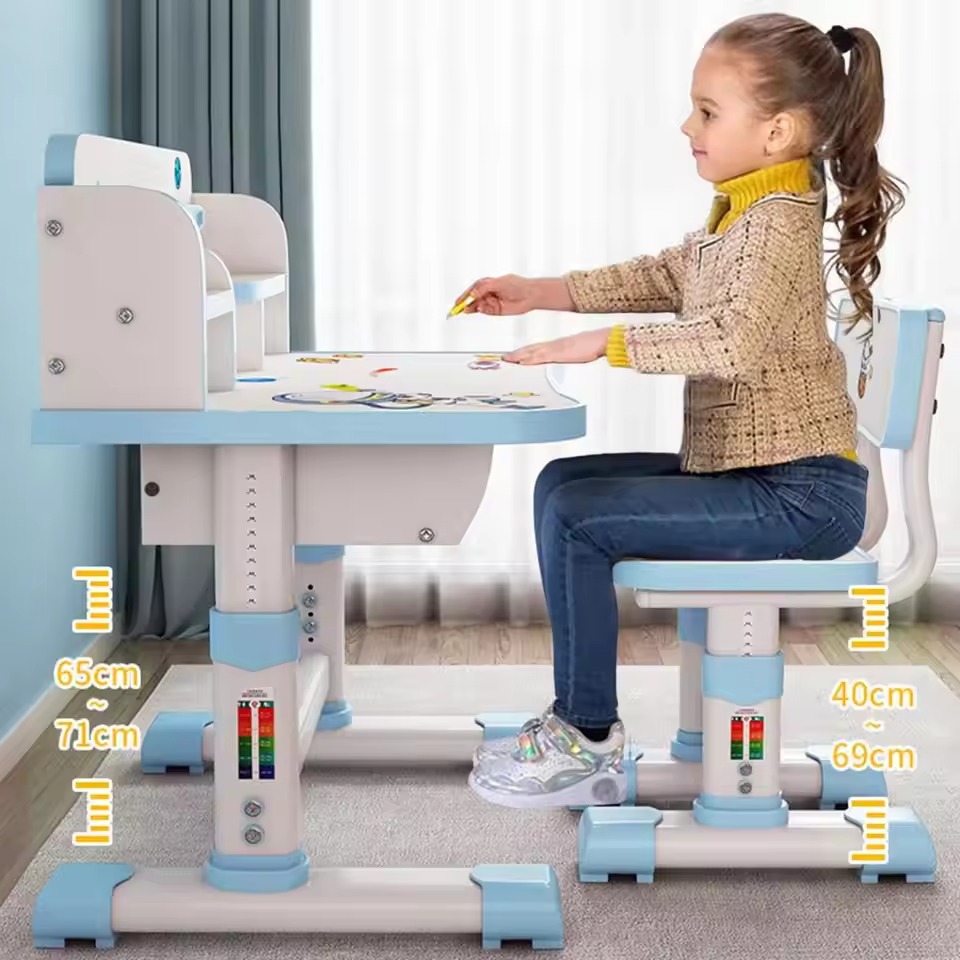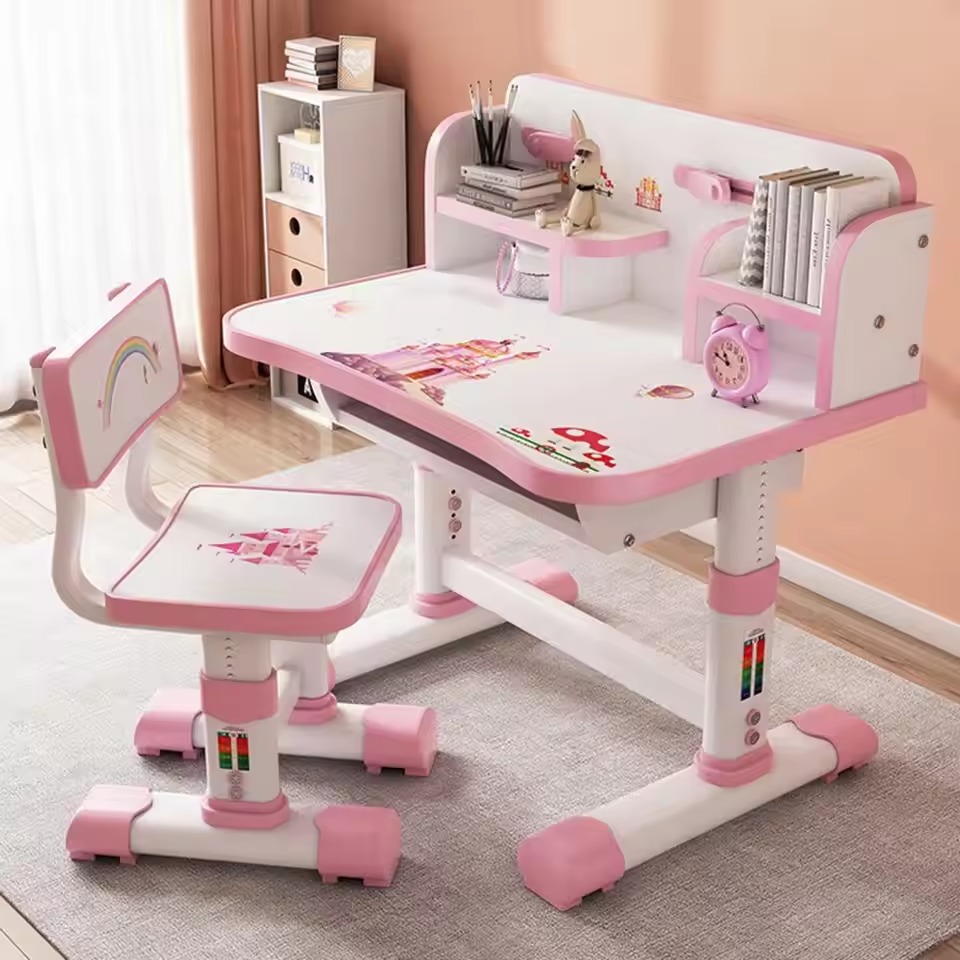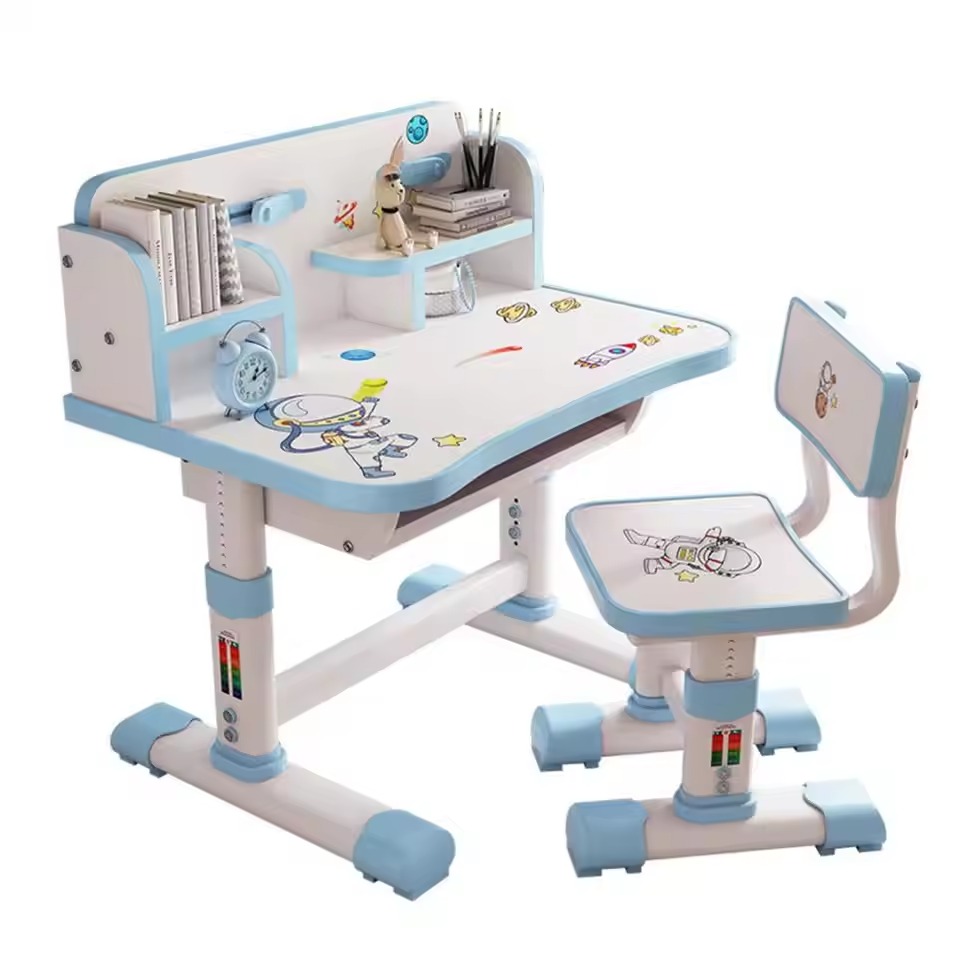Importance of Proper Desk Height for Kids
Choosing the right kids desk height is vital for your child’s comfort and health. A desk that is too high or too low can lead to poor posture. This in turn could cause back and neck pain, as well as eye strain. Children spend long hours at their desks, doing homework, reading, and similar activities. Therefore, it’s important to ensure their workspace is ergonomically suited to their needs.
The correct desk height allows your child to sit with their feet flat on the ground. Their legs should be at a 90-degree angle, with arms resting comfortably on the desk surface. Also, their shoulders should be relaxed, not hunched up or overstretched. This position helps in maintaining a good posture and supports proper wrist positioning while writing or typing.
An ideal desk height can keep up with your child’s growth and changes in their needs. As kids grow, their desk should adapt to their new height. That’s why adjustable desks are becoming a more popular choice
among parents. With an adjustable desk, you can easily change the height to match your child’s growth spurts. Thus, maintaining an ergonomically sound study environment over time.
Not only does the right kids desk height contribute to physical well-being, but it can also enhance focus and concentration. When children are comfortable, they are less likely to fidget and more likely to stay focused on their tasks. A well-sized desk can also help in organizing school materials, which in turn supports good study habits.
In summary, the proper desk height is crucial for a child’s physical health and academic performance. Investing in a desk that meets these ergonomic standards is an investment in your child’s overall well-being.

Factors to Consider When Selecting a Desk Height
When choosing a kids desk height, several factors come into play to ensure ergonomic comfort and health. It’s not just about picking a desk; it’s about matching the furniture to your child’s physical proportions and their specific needs.
Firstly, consider the child’s age and corresponding average height. Different age groups have varying average heights, which can serve as a starting point for selecting a desk. However, remember that every child is unique, and their individual measurements are what truly matter.
Secondly, look at the child’s leg length. The desk should allow them to sit with their knees at 90 degrees and feet flat on the floor. This is critical for proper posture and comfort.
The third factor is the distance from the elbow to the home row of the keyboard if they’re using a computer. Their arms should be able to bend at a comfortable angle without reaching too high or dipping too low.
Additionally, pay attention to the desk’s width and depth. The child should have enough space to work without clutter, but also be able to reach everything without stretching.
Lastly, consider future growth. Opting for an adjustable desk could be a wise investment as it can grow with your child and remain ergonomically suitable over the years.
Balancing these factors with the concept of kids desk height is important for the child’s health, concentration, and overall well-being. Remember that a well-fitted desk can make a significant difference in a child’s educational experience.
Average Desk Height Recommendations by Age Group
When outfitting your child’s study area, considering the average kids desk height recommendations for various age groups is a good starting point. Although personalized assessments of your child’s measurements are best, these general guidelines can help narrow down the options. Here is a simple breakdown by age group:
- 3-5 years old: Desks for this age group should be around 19 to 22 inches in height.
- 6-8 years old: Aim for a desk height between 22 and 25 inches.
- 9-12 years old: A desk height of 25 to 28 inches works well for this age range.
- Teens: Desk heights for teenagers can range from 28 to 30 inches.
Remember, these heights are starting points. Your child’s comfort should guide the final selection. It’s vital for the desk to support their feet resting flat on the floor, knees at a comfortable 90-degree angle, and arms at the correct height for writing or typing without strain.
Adjustability is key, so consider choosing a desk that can adapt. A desk that can be modified over time will ensure that your child always has an ergonomically beneficial workspace, even as they grow. Keep these age-specific height recommendations in mind to create a comfortable, focus-enhancing study area for your child.
Adjustable Desks: A Long-term Solution
Adjustable desks stand out as a smart choice for a child’s study space. As kids grow quickly, a fixed desk height soon becomes unsuitable, leading to uncomfortable and unhealthy postures. An adjustable desk, on the other hand, can evolve with your child’s changing needs.
Investing in an adjustable kids desk height ensures correct posture over the years. Children can alter the desk height to remain in line with the ideal posture guidelines. This involves keeping feet flat, knees at 90 degrees, and arms comfortably on the desk. This way, the investment in an adjustable desk pays off not only in comfort but in health benefits as well.
The versatility of adjustable desks allows for shared use between siblings of different ages. This creates a cost-efficient solution for families with multiple children. Moreover, it encourages each child to maintain a correctly personalized workspace, supporting individual ergonomic needs.
Ease of adjustment is another factor that makes these desks a practical long-term solution. Look for features such as easy-to-use levers or hydraulic systems that allow your child to make adjustments independently. This cultivates a sense of ownership and responsibility for their own comfort and health.
The adaptability of adjustable desks can handle more than just height changes; they can also accommodate different tasks. Whether your child is writing, reading, or using a laptop, the desk height can be modified for the activity at hand, maintaining ergonomic integrity.
In summary, adjustable desks for kids offer a flexible and enduring benefit, making them a wise choice for attentive parents. They support a child’s growth, encourage proper posture, and can be a shared asset for the whole family. That’s why they’re increasingly popular in homes and schools alike.

Ergonomic Considerations for Children’s Desks
When we talk about ergonomic considerations for kids desk height, we look beyond the basic numbers. Good ergonomics addresses the alignment and comfort of the entire body when a child is seated at their desk. Here are key points to remember:
- Posture is Priority: The spine should maintain a natural ‘S’ curve when seated. A desk that’s too high or low disrupts this curve.
- Elbow Angle Matters: Kids’ elbows should be at a 90- to 120-degree angle when resting on the desk. This reduces strain on arms and shoulders.
- Eye Level is Important: The top of the computer screen or reading material should be at or slightly below eye level to prevent neck strain.
- Leg Room is Critical: Ensure there is enough space under the desk for leg movement. A cramped space can lead to discomfort and restlessness.
- Desk Surface Space: There should be ample room on the desk for books, papers, and other study tools without overcrowding.
- Chair Compatibility: Pair the desk with a chair that allows kids’ feet to be flat on the floor. Chair height and desk height should go hand-in-hand.
- Tool Accessibility: Pencils, notepads, and other supplies should be within easy reach to prevent overreaching and twisting.
Each of these points focuses on creating a study environment that promotes a healthy and productive posture for children. Ergonomics is about more than just the physical well-being; it’s about fostering an environment that enhances the ability to concentrate and learn effectively.
Measuring Your Child for the Perfect Desk Fit
Getting the right kids desk height starts with accurate measurements. Start by having your child stand straight, with their back against a wall. Use a tape measure to find the distance from the floor to their elbow. This measurement will guide the ideal desk height, allowing their arms to rest comfortably without strain.
Next, measure the length of your child’s leg from the knee to the heel while they are seated. Aim for a desk and chair combo, where this measurement allows their feet to be flat on the ground with a 90-degree angle at the knees.
For the desk width, observe your child’s shoulder span. The desk should match this span to give room for movement and help keep the body aligned.
Don’t overlook the importance of a chair that fits the chosen desk. The chair should allow your child to sit back with their feet touching the floor. This goes hand in hand with desk height to maintain good posture.
Write down all these measurements and keep them handy when shopping for a desk. Remember, comfort equals focus. When a desk fits just right, your child can concentrate better on their studies.
If you select an adjustable desk, learning how to adjust it is crucial. Teach your child, so they can change it according to their comfort as they grow. This way, they learn about ergonomic health early on.
In essence, correct desk fitting for your child ensures they won’t face the discomfort that disrupts their productivity. It’s about creating a seamless space where they can thrive academically.
Top Kids Desks with Ideal Height Features
When it comes to selecting a desk for your child, the ones with ideal height features stand out. These desks ensure your child can maintain a natural, comfortable posture while studying. Adjustable desks, in particular, are invaluable for their ability to grow with your child. Here are some desks that are top-rated for their ergonomic benefits and height adaptability:
- Height-Adjustable Desks: Many brands offer desks that you can easily adjust in height. This is perfect for keeping up with your child’s growth. Look for desks with a smooth adjustment mechanism.
- Tiltable Desktop Desks: Desks with a tiltable desktop allow your child to angle their work, reducing strain on the neck and eyes.
- Desks with Storage: A desk with integrated storage helps keep school supplies within easy reach, reducing clutter and the need to stretch.
- Compact Desks: For smaller spaces, compact desks are available that still allow for height adjustment without taking up too much room.
These desks vary in material, design, and specific features. They often come with guides or indicators making finding the perfect height easy. Ensuring the desk you choose matches the ergonomic considerations discussed earlier is important. It’s not just about the kids desk height; it’s also about supporting your child’s health and learning process.

Tips for Combining Desks with Ergonomic Chairs
To create the ideal study space, combine the kids desk height with an ergonomic chair. Here are some tips:
- Choose the Right Chair Size: The chair should fit your child’s body. Their feet must touch the floor, and knees should bend at 90 degrees.
- Check for Lumbar Support: A good chair offers lower back support. This help keeps the spine in a natural position.
- Look for Adjustable Features: Chairs that adjust in height and backrest angle are best. They can adapt to your child’s growth, just like an adjustable desk.
- Consider Armrests: Chairs with armrests can reduce shoulder strain. Make sure they don’t keep the child too far from the desk.
- Test Stability and Movement: The chair should be stable but allow freedom of movement. Swivel chairs with wheels are a popular choice.
- Match the Desk and Chair: Ensure that the chair and desk heights align properly. Your child should sit comfortably with their arms at the right height on the desk.
- Adjust Both Together: When you adjust the desk, adjust the chair too. They work as a team to give your child the best ergonomic support.
By following these tips, you can pair a desk and chair that promote healthy posture. This can improve concentration and comfort during study time.
